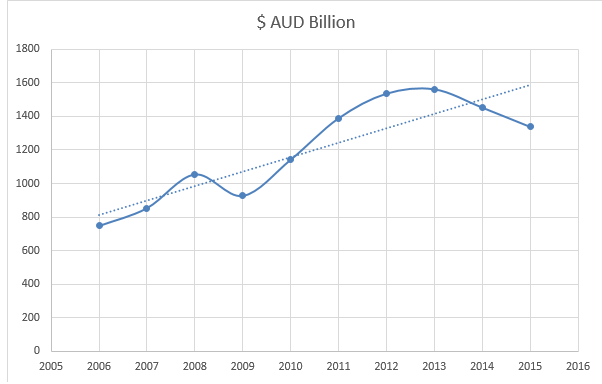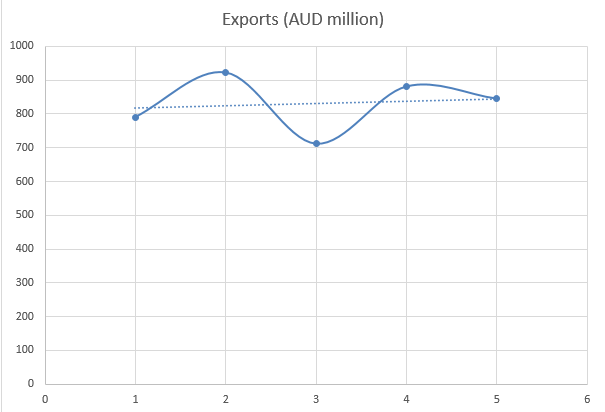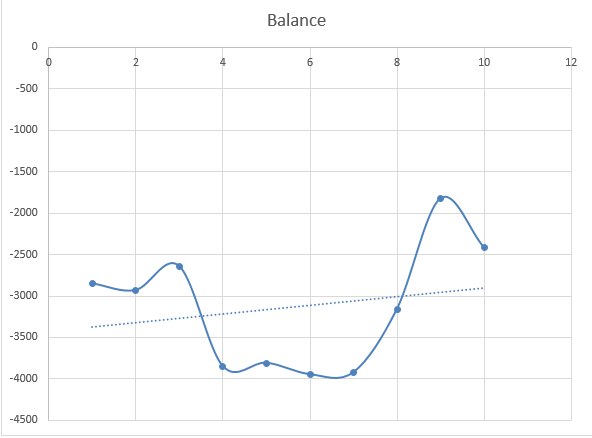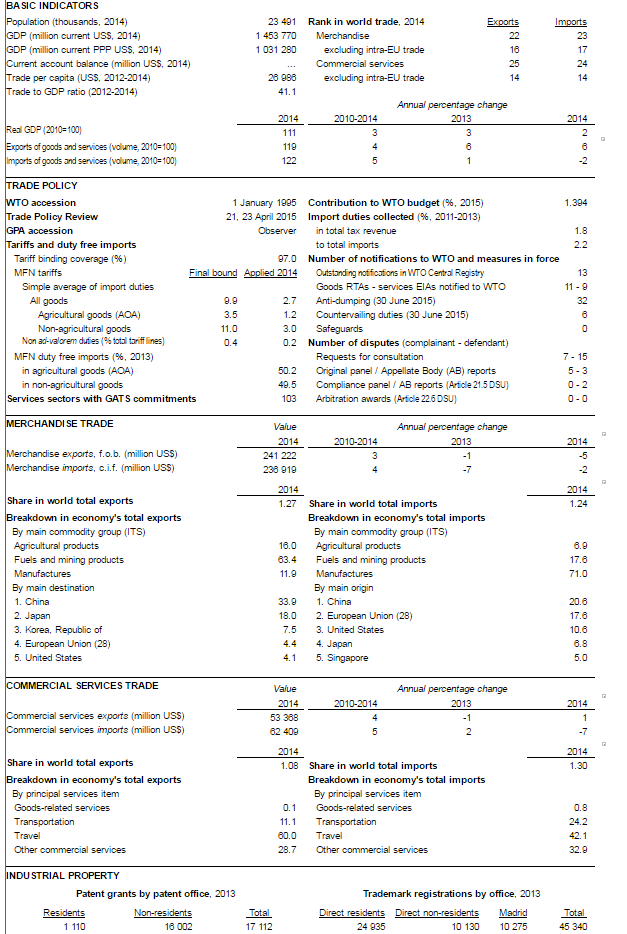Introduction
An overview of the essential information about the correlation between the exported and the imported goods, which the trade flow is typically defined as (Behar and Nelson 7), is vital to the success of the strategies adopted by the state government in the economic area. Unless the state authorities apply the necessary measures to handle the increase in import and, therefore, prevent the state economy from becoming consumption-oriented, a rapid economic downfall is expected.
As far as the Australian economy is concerned, the state exports a range of products, which allows it to maintain a rather strong position in the global economic environment despite being geographically isolated from the European and the American markets. Among the products that can be deemed as the trademarks of the Australian economy, wool has to be named. Although the need for wool seems to have dropped due to the increase in the artificial substitutes, which are cheaper and of nonetheless high quality, Australia remains an important exporter of wool, which means that its trade flow is likely to grow as long as the production thereof is supported and the private companies are encouraged.
Data Description
The general data on the Australian trade flow can be considered quite positive. According to the information provided by WTO, the GDP of the state has been growing since 2012 (see Appendix A) (World Trade Organization par. 1). Indeed, a closer look at the state’s GDP will reveal that, though having experienced some ups and downs in its economic progress, Australia has been showing remarkable progress (see Fig. 1).

Similarly, the wool industry has been expanding over the past few years, according to the official data. Specifically, the fact that the state imports a total of 845.00 million AUD on an annual basis deserves to be brought up (Trading Economics “Australia Exports” par. 4).
However, one must admit that the rates of wool trade flow have dropped slightly over the past few years (see Fig. 2 below). The observed phenomenon is not quite surprising, seeing that an array of new products has emerged in lieu of the natural woolen clothes (in the apparel industry) and the related items (e.g., the lanolin in the cosmetics industry).

A closer look at the subject matter will show that the balance of trade in Australia has been suffering negative changes as well. Which is even more disturbing, the trade flow rates have been rather inconsistent over the past few years. It would be wrong to state that Australia has been going consistently downhill in its economic department. Instead, the trade flow rates have been going through regular ups and downs. For instance, Fig. 3 shows that there has been a vast improvement between January and April 2016, yet the trade flow rates were reduced shockingly low in April again.

Data Analysis and Results Discussion
As the charts provided above show, the trade flow rates in Australia are an evident reason for concern. Despite the fact that the subject matter is not plummeting on a regular basis, the way in which it alters points to the necessity to introduce a set of measures for improving the state economy.
The same can be said about the wool industry area. The reasons for the wool trade to experience a downfall are quite understandable – in the era of technological development, the range of substitutes that have entered the market recently does not allow for a successful promotion of the wool-based products among the target customers. The combined cheapness and efficiency of the substitutes makes the latter a much more sensible choice to make when considering the buying options (Alam and Imran 71).
Therefore, current trade issues need to be fixed immediately. The problem of the drop in the wool export rates, as well as the overall trade flow process, will have to be addressed by analyzing the factors that affect the trade flow and isolating the ones that have a pronounced negative effect on the subject matter. For instance, the shipping costs will need to be assessed with the further identification of the means of reducing them.
At this point, the supply chain management tools used by the Australian companies, including both private and public ones, must be brought up. Specifically, the Australian authorities will have to provide private and public organizations with an opportunity to reduce the costs of shipping by offering more options as far as the choice of the logistics-related strategies, and especially transportation, is concerned.
The graphs provided above also point to the fact that the trade flow rates have been arguably experiencing a minor improvement in March and April 2016. Indeed, a closer look at Fig. 3 will show that the Australian economy faced a rapid improvement in March as the trade flow rates went from -$3.16 billion AUD to -$1.84 billion AUD. Differently put, the growth spurt that the state economy has been under equals a 41.77% improvement in the designated area. Therefore, it is imperative to identify the factors that the Australian economy was facing at the time and reconstruct them so that the growth process could continue.
It should be kept in mind, though, that the process of providing the environment that will be favorable to the Australian trade needs to be carried out with caution. Particularly, the changes in the economic environment imply that some of the factors affecting the Australian rate positively a few months ago maybe neutral or even downright harmful to the state economy at present.
Seeing that the current trade flow rates are clearly negative and that the trend line for the Australian wool industry development leaves much to be desired at present, it is necessary to reconsider the approaches used for the product promotion to the target customers. Particularly, an increase in the competitive advantage of the organizations producing wool and woolen goods will need to be designed or increased in the global market.
Conclusion
There is an obvious propensity for the Australian wool industry, as well as the overall trade flow, to reduce significantly. The observed phenomenon shows that the state authorities will have to reconsider the approaches used to provide public and private entrepreneurship with the supply chain management tools. Specifically, numerous options for improving the logistics chain will have to be created. Particularly, the costs for the goods shipping and the delivery of the raw material to the corresponding enterprises will have to be viewed as the primary goal.
Although a drop in expenses for the supply chain management processes cannot be viewed as the only solution to the problem, it is likely to set the background for the further increase in the trade flow rates. Opening new opportunities for the Australian entrepreneurship leaders, it will allow for rapid growth.
Appendix A: Australian Trade Report (World Trade Organization par. 1)

Works Cited
Alam, Izhar, and Mohammad Imran. “Indo- ASEAN Trade Pattern: An Empirical Analysis.” International Journal of Research in Management & Social Science 3.1 (2015): 70-78. Print.
Behar, Alberto, and Benjamin D. Nelson. Trade Flows, Multilateral Resistance, and Firm Heterogeneity. Washington, DC: International Monetary Fund, 2012. Print.
Trading Economics. Australia Exports. 2015. Web.
Trading Economics. Australia Exports of F.o.b – Wool & Sheepskins (Quarterly). 2015. Web.
Trading Economics. Australia GDP. 2016. Web.
World Trade Organization. Australia. 2014. Web.